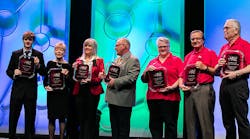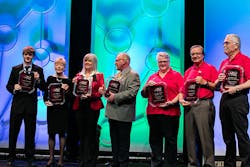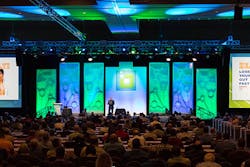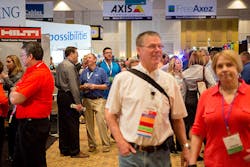Held from February 1 to February 4 at the Rosen Shingle Creek Hotel and Convention Center in Orlando, the BICSI 2016 Winter Conference created important discussions around the design and implementation of communications networks. In addition, the demands being made on copper and optical fiber cabling are fostering new ideas in cable constructions and typologies, and in the development of new or revised BICSI standards.
Many changes are on the horizon, due to the Internet of Things (IoT), which allows almost everything to be interconnected in an effort to increase productivity, deliver more value, and create better experiences for customers and end users. This initiative is being helped with the development of new and revised standards and associations. For example, Cisco, GE Digital, Intel, Microsoft, Qualcomm, Samsung and other industry giants are forming the Open Connectivity Foundation (OCF) to allow different devices and operating systems to function seamlessly with one another, and to make the cloud — a place to aggregate and crunch all that diverse date — more secure. Gartner Research estimates that the number of “things” linked together in 2015 was about 5 billion units, a number that should grow by 30% this year and reach 21 billion in 2020.
Proposed 2017 NEC Changes
Structured cabling, which is increasingly being used to transport DC power for a variety of devices and services, is very much in the spotlight. For example, in an October 2015 meeting, the National Fire Protection Association (NFPA) Cde-making groups discussed revisions to the NEC for the upcoming 2017 edition. A major subject area for the new Code is Power-over-Ethernet (PoE) technology, which allows low-voltage DC power to travel over the same (Category type) copper structured cabling used for Ethernet data transmission to serve lighting, building controls, security cameras, and other devices.
The concern is that in PoE applications, the circulating DC power can generate a large amount of heat within the cable, therefore leading to safety and performance concern, especially when the cables are bundled. Thus, there is a proposal to create a new class of communication cable for operating temperatures greater than 60°C, with designated ampacity limits for powering. Also proposed is a new ampacity table for 4-pair cables in a bundle.
The proposed Table 725.144 is inconsistent with TIA draft TSB 184 and based solely on a single test report without collaboration from other standards bodies. Whereas the TIA TSB 194-A results come from analysis of temperature rise versus current measurements by multiple cable manufacturers, as well as input form IEEE/ISO and IEC. Connectors, patch cords, cross-connect wiring, patch panels, consolidation points, etc., would also require extended operating temperature specifications.
As mentioned previously, the proposed Code additions include a new class of communication cable — called LP cable — to support conductor ampacity values exceeding 802.3af, 802.3at and proposed 802.3bt values. No reference is made to IEEE 802 standards, ISO/IEC or TR 29125 or TIA TSB 184-A.
In its November 2015 plenary meeting, the IEEE 802.3 task force voiced concern that while the language of the Code exempts powering communications equipment up to 60W, the proposed new language could lead to confusion as well as to regulation of PoE cabling and equipment installations.
Concurrently, an upcoming IEEE high-power PoE standard is slated for ratification in 2017, allowing for delivery of 60W to power sourcing equipment (PSE). Many new configurations under development use all eight conductors of the cable, while simultaneously being backward-compatible with 802.3af PoE and 802.3at PoE+.
Educational session highlights
The educational sessions included the following:
In “Next Generation Multimode Fiber,” John Kamino of OFS in Norcross, Ga., explained that 40 Gb/s and 100 Gb/s Ethernet speeds are becoming widespread in data centers today. Thus, work is underway to develop 400 Gb/s Ethernet and 256 Gb/s Fiber Channel standards for the next generation networks. These solutions include short wavelength division multiplexing, which transmits multiple channels on one duplex multimode fiber pair; multilevel signaling, and spatial division multiplexing.
“Will High-Power Ethernet (HPoE) Change Installation Practices for New and Existing Cable Plants?” presented by Rick Foster of Innovative Engineering Services in East Haven, Conn., and Andrew Jimenez of Anixter in Glenview, Ill., described how new High-Power Over Ethernet (HPoE) or PoE++, HDBaseT, or proprietary applications that deliver more than 30W will affect cabling systems in the future. They reviewed how codes and standards organizations are addressing the higher current levels and possible changes in installation practices.
In “HDBaseT – Structured Connectivity for Digital AV,” Mike Jinkerson of Legrand in Jackson, Mo., spoke about the latest digital AV technology, such as UltraHD, which requires as much as 20 Gb/s through-put. And, in AV applications, the Power over HDBaseT (POH) is based on the IEEE 902.3at standard with appropriate modifications to deliver up to 100W over all four-pairs of the Ethernet cable.
In “The Impact of NBase-T on Wi-Fi Deployment,” Roger Matthews of CommScope in Richard Hill, Ontario, Canada, spoke about the impact of 802.11ac Wave 2 and 802.11ax on network design and network access. The 802.11ac Wave 2 technology uses downlink multi-user multiple input/multiple output (MU-MIMO) to send data to four clients simultaneously, reducing contention and improving network performance.
The session “What to Do with an Aging UPS,” presented by John Gray of Schneider Electric in O’Fallon, Mo., focused on the fact that with a large percentage of mission critical UPSs approaching end of life (EoL), the options for maintaining continuity of reliable power should be understood. These include:
1) Run to failure, which is commonly done when the manufacture removes support and maintenance.
2) Revitalization of the UPS, which offers possible power efficiency enhancements and less risk compared to the replacement option.
3) Complete replacement with new equipment, which offers the lowest long-term risk profile. He offered a broad review on the economics of each option, for both traditional and modular type UPS units.
In “Cable Pathway Use and Selection and the National Electric Code,” Eric Sadler of Snake Tray in Bay Shore, N.Y., noted that the NEC has Sections for each pathway type with installation requirements to prevent physical hazards, while describing the relevant portions of the Code regarding safe currents for each cable type including temperature correction factors for cables normally rated at 30°C. He also highlighted requirement found in Sec. 725.24 and Sec. 800.24 of the NEC.
Frank Straka of Panduit in Orland Park, Ill., described the next generation of PoE which allows devices with greater power demands to be served by Ethernet cabling systems in his session, “The Impact of Higher Power PoE++ on Twisted Pair Structured Cabling.” The TIA TSB 184-A document delivers up to 1,000mA current on all four pairs of the structured cable plant, while recommending that cable bundle temperature rise be limited to less than 15°C. Cable insertion loss de-rating should also be understood, as well as the fact that when unplugging an active PoE circuit, an arc (or spark) occurs between the plug and jack contacts.
In “The Impact of Remote Power on Balanced Twisted-Pair Cables,” Paul Cave of Excel Networking in Birmingham, U.K., offered ways of mitigating the heating effect of PoE, which accelerates the ageing of the cable, and thus its performance. For example PoE+ supports 34.2W, Cisco’s proprietary UPoE supports 60W, and the IEEE is discussing more than 100W for 802.3bt. Ways to reduce cable heating include: use short horizontal cable runs, use screened cable, use mid-span devices and avoid large bundling of cables (25mm minimum gap between cable bundles).
“Workplace and Building Trends: Digital Building Infrastructure,” presented by Todd Frederes of Cisco Systems, Inc. in Clive, Iowa, offered a view of how the Internet of Everything (IoE) world is involved in changing both the workplace environment and office building design. Cisco sees a future for smart buildings where Ethernet cables and the associated RJ45 plugs and connectors provide power (PoE) to the overhead general lighting system, allowing integrated sensors to detect ambient light levels, human presence, temperature, or carbon dioxide levels. The company believes that because PoE lighting systems can be installed in a relatively short period of time and are infinitely adaptable, they will become commonplace — similar to the way VoIP has changed the desktop telephone system.
In fact, five floors of an office tower in Toronto, Canada, which houses Cisco’s new Canadian corporate headquarters, uses a PoE structured cabling system for the general overhead lighting. Federes acknowledged that this scenario changes the traditional role of the electrical contractor and the IT technician, and that craft conflicts are most likely going to be resolved locally by the building trade professionals in each region of the country.






